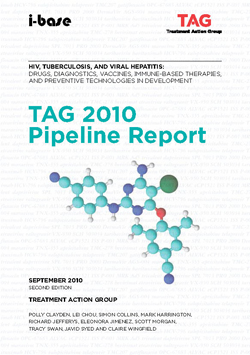HIV, Tuberculosis, and Viral Hepatitis: Drugs, diagnostics, Vaccines, Immune-based therapies, and Preventive Technologies in Development
September 2010 – Second Edition
By Polly Clayden, Lei Chou, Simon Collins, Mark Harrington, Richard Jefferys, Eleonora Jimenez, Scott Morgan, Tracy Swan, Javid Syed and Claire Wingfield
This year TAG collaborated with HIV i-Base UK. Simon Collins contributed an in-depth analysis of the Antiretroviral Pipeline and Polly Clayden wrote new chapters for the report on Pediatric Antiretrovirals and HIV diagnostics. The second edition includes information from the XVIII International IAS Conference in Vienna, Austria, July 2010.
From the introduction:
For the sixth time, Treatment Action Group (TAG), now in collaboration with HIV i-Base (UK), presents the current clinical pipeline for new drugs and vaccines for HIV, hepatitis C virus (HCV), and tuberculosis (TB), along with new sections on the hepatitis B virus (HBV) pipeline and diagnostics for TB and HIV. Despite a forbidding economic and political climate, the science presented at the XVII International AIDS Conference in Vienna, Austria, between 19-23 July 2010 was some of the most remarkable in many years. For the first time since the late 1990s the quest for a cure for HIV disease has emerged as a major priority with new tools and approaches linking academic and industry science in an exciting new research area. See Richard Jeffery’s brief introduction to some of the emerging scientific issues on page 46. And in the first encouraging HIV microbicide study of a direct-acting antiretroviral vaginal gel, the CAPRISA 004 study of tenofovir 5% gel provided 39% protection against vaginal HIV acquisition and a surprising 51% protection against vaginal herpes simplex virus type 2 (HSV-2) acquisition. This double whammy could reduce HIV transmission both directly and by limiting HSV-2 infection which has been shown to increase the risk of acquiring HIV. New follow-up studies are urgently needed to confirm and extend the promising results of CAPRISA 004; see Richard Jefferys’ discussion on pages 57-58.
Even with the global economic crisis and the erosion of political will to continue scaling up effective, lifesaving, evidence-based preventive and treatment interventions for HIV and its most common coinfections worldwide, TB, HBV and HCV, the scientific outlook is unexpectedly positive. Continuing growth and maturation in the HIV therapeutics market space have not yet led to a visible diminution of efforts by industry to discover and develop new antiretroviral drugs and classes. A pair of antiretroviral drugs approved in 2006 and 2007—the protease inhibitor darunavir (Prezista, Tibotec/Johnson & Johnson) and the first-in-class integrase inhibitor raltegravir (Isentress, Merck)—joined efavirenz (EFV) and boosted atazanavir (ATV) as preferred first-line anti-HIV drugs in combination with tenofovir (TDF)/emtricitabine (3TC) (combined as Truvada) in the U.S. Department of Health & Human Services adult and adolescent HIV treatment guidelines published in December 2009. These advances show that there is a continued market for innovation in HIV treatment and that industry, regulators, and public health authorities agree on how best to study new drugs in order to rank them relative to existing regimens. In the coming years there may be fewer persons experiencing multidrug class failure to participate in earlier phase studies, which means that new trial designs will be needed; thus, the over $10 billion yearly market for HIV therapy will continue to experience dynamic changes and evolution. Five new compounds and combinations are in advanced phase III studies and expected to be filed for U.S. Food and Drug Administration (FDA) review in 2010–2011: Tibotec’s nonnucleoside reverse transcriptase inhibitor rilpivirine (TMC278); the triple combination with tenofovir/3TC/rilpivirine; Gilead Science’s integrase inhibitor elvitegravir; the novel pharmacokinetic enhancer cobicstat; and the so-called Quad pill containing elvitegravir/cocibstat/tenofovir/3TC. Additional drugs in existing and new classes, the latter including maturation and attachment inhibitors, are in earlier phases of testing.

